Menus
- Discovery
- In the saddle
- Contact
- City
- Highway
- Departmental
- Night road
- Comfort
- Braking
- Convenient
- Consumption
- Conclusion
Five-day test of the 2007 vintage roadster
The Kawasaki Z1000 released in 2003 was well received but
mixed: a look of hell but an engine considered
like trough at mid-speed. As a result, many users
made it unbridle to restore it to its original character.
Kawasaki has therefore listed all the grievances of the owners
before releasing the 2007 version … Success ?
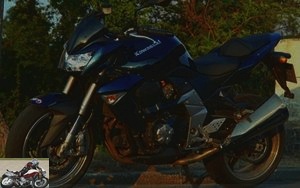
Discovery
The 2007 vintage is the obvious choice. Massive, stocky, seeming to be
cut with a billhook, the Z 1000 now seems to come out
straight from a manga, Akira sauce.
Kawasaki fashion for fairings including turn signals continues
here. The huge double pots (compared to the flutes
of the previous model) contribute to giving
this monstrous aspect. A shoe protects the lower engine and the outlet
of exhausts.
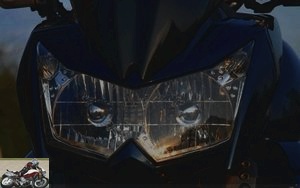
In its metallic blue livery, it gains in elegance…
a rare color – rewarding compared to black and less flashy than
orange – which turns all heads.
The double-stage, indented saddle seems
both thinner and thicker for the passenger. The back
ends in a triangle and the LED light fits perfectly.
Quadruple raised exhaust is simply superb.
It highlights a huge 190 mm sausage, Dunlop Qualifier. Corn
it is the heart that emerges with an immense radiator, a reservoir
imposing (despite its only 18.5 liters) and above all an engine
prominent and black.
Only the engine remains from the ZX-9R, "just" reworked
to give more torque at low and mid-range: modified cams,
crankshaft, heavier masses, new exhausts, new staging
gearbox, remote fixing points based on
side reinforcements.
The 2007 model gives the blow a big blow of old to
the old model … already relegated to
dungeons? not so sure…
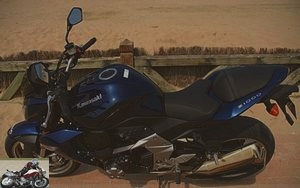
In the saddle
Sitting, the position is immediately natural, arms bent,
lightly pressing forward. On the other hand, the feet
barely touch the ground for the 1.70m pilot … on the tips
same ! It seems that she gained a few centimeters
in height despite a narrower saddle compared to the old one
model (40 mm shorter); yet officially the height is
identical.
The tachometer has been completely revised, winning
in modernity and above all in readability. The tachometer included
a fuel gauge. On the right, a totalizer, a clock, a
trip (single), and a temperature indicator. Nothing is forgotten,
apart from a warning, however existing on the Z 750. The mirrors
rectangular diamonds are easily adjusted but allow
especially to see the arms. On the other hand, they offer a clear image, without
never be bothered by any vibration.
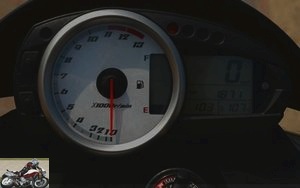
Contact
Rahhhh, that sound … both hoarse and muffled! We already have
want to let go of the beast. Clutch, start. The Z
share on a trickle of gas.
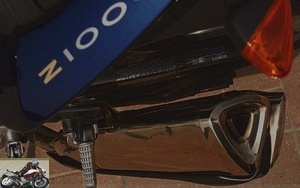
The legs enclose the enormous tank, so
slightly apart (much further apart
especially an ER6 but without excess). The bike tightens despite
quite naturally by offering very good stability.
The box is soft and pleasant to use,
without dead point, or particular hooking.
We then feel the 7kg of overweight taken compared to the old one
model (and 11 kg more than the Fazer).
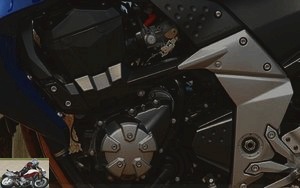
City
Wheelie beast! At each start, the sound of the engine
makes you want to jump. And if we open too hard, the Z rears up. This is
there that we feel all the work done to give
more torque on the bike from the lowest revs,
compared to the old model.
If his overweight is significantly higher than a Z750 –
and a fortiori to an ER6 – it handles despite everything
easily, without the need for force. She swings easily and
glides smoothly in traffic jams.
Kawasaki having done a lot of work on the injection, there is no
no more jerks on the go-around.
The first amount briskly to 100 km / h, and the
2nd at 130 (not in town of course), she could stay on
these two reports to switch from one fire to another in a flash,
especially since it is no longer necessary to climb the towers for the
see expressing oneself. In fact, it even allows you to roll up without having to
stroke in 6th at 1200 rpm !
In the end, the box turns out to be better staged
than the previous model and overall shorter
(especially the 6th).
Easy to drive, it allows you to drive in town for a long time, without generating
no fatigue, related to weight or position. All at
worse, can she give off some heat from the side
left.
With a limited turning radius and increased weight, the Z forces
on the other hand, more than another to be well balanced in order to succeed
a U-turn: the only downside for the city.
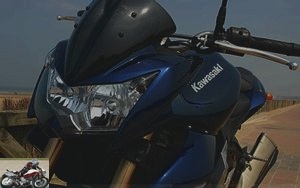
Highway
The passage on the motorway is always scary for a roadster not having
no protection.
At 100 km / h at 4,000 rpm, the Z then takes roughly
25 km / h every 1,000 rpm. It is thus stalled at cruising speed
at 150 km / h and 6,000 rpm, while having a large reserve
power: 5,000 rpm to the red zone and enough to exceed
gleefully … too fast !
The mini windshield perfectly fulfills its role up to
150 km / h without hindering the pilot or generating downforce
individuals. Protection proves to be much more effective than the model
previous … and allows largely prohibited speeds
by the law.
Its higher weight complemented by a longer hunt
(98mm to 103mm) give it in return a stability
larger than a Z750, and less sensitive to both wind
and overtaking of trucks.
Departmental
It is with undisguised joy that the Z finds its way back to
the departmental. The torque available from low revs
allows it to stay on the same gear almost all the time,
depending on the type of driving desired by the pilot.
It can stay permanently in 6th gear to wind up at 30 km / h in
the villages at 1200 rpm then accelerate again
right out of the box, while having regular sensations.
it then gradually accelerates to
6.000 rpm then frankly from there and until
10,000 rpm.
Or, she stays in 3rd, to climb the towers … especially between
5,000 and 8,000 rpm where it provides the most sensations and
reactions. In these laps, and whatever the bends, the
chassis is very rigid and without blurred movement. Corn
wanting to go faster, with more extensive use,
the Z 1000 then asks to be taken more by the
pilot and a little less instinctive than its predecessor.
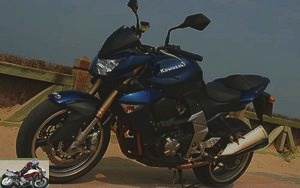
Night road
The Z 1000 illuminates well, with a wide beam. The passage in
full headlight provides additional power, particularly in terms of
distance without illuminating more on the sides. It is largely
sufficient to drive over speeds anyway
authorized. The meter is always readable, even at night.
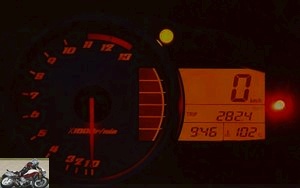
Comfort
It’s a roadster, Kawasaki moreover. The saddle is hard, the suspensions
firm. The motorcycle gains in efficiency but loses in comfort, too
good for the pilot and for the passenger.
If the road is in bad condition, and the suspensions are adjusted
normally there is an immediate rodeo effect (relaxation
to be adjusted to limit this effect).
For the passenger, the height position allows to admire the landscape.
The molded saddle seems to offer at first glance a
good seat. In fact, the passenger begins to suffer past
the first fifty kilometers. In addition, the motorbike inciting to
a nervous ride, the saddle does not prevent sliding forward
and it is necessary to tighten the legs or hold tight
to the pilot … because there are still no passenger handles.
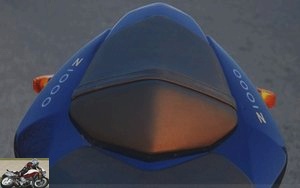
Braking
The rear brake is a vague retarder … which does not risk
to block, even by crushing the pedal !
The front on the other hand is surprising at first glance, with a lot of
biting very quickly. You have to learn to dose it, with two
fingers at first, before you can take it more violently. TO
handle with dexterity in the wet. On the other hand, the additional
power is better suited for this new model.
And in the end, you get used to it very quickly without any particular surprise.
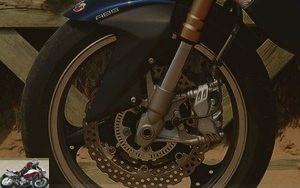
Convenient
There is no space under the saddle (neither rider nor passenger, except on
the non-ABS model for the pilot). So, we must forget the anti-theft.
Anyway, it is impossible to place it in the front wheel.
And for the back, the only solution is to do it
pass through a hole in the rear crown and a stick (and again
certain models of locks only). We can then always
place the lock with the strap of the passenger seat.
The tank is made of metal. It is therefore possible to affix
a magnetic bag (because the top case, blah). Hooks
placed under the passenger seat allow easy stowage of a
spider.
The absence of a wheel arch generates large waves of
dirt on the back of the pilot (and / or passenger) up to
the back of the neck in rainy weather. Think about planning the combination…
or the wheel arch.
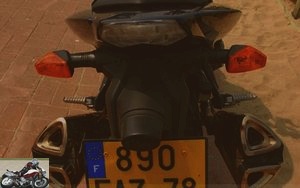
Consumption
The tank gained half a liter, to 18.5 liters,
with the 2007 vintage.
The fuel gauge – made up of six good sticks
visible – proves to be very precise at
usage. The first stick disappears after 90 km, each other
stick disappearing after 35 km. At the 6th stick, and approximately
250 km, the passage on reserve is visualized by a "FUEL"
turn signal. When driving in coils, the Z1000 turns at
6.2 liters per hundred but easily goes up to 8 liters when driving
muscular.
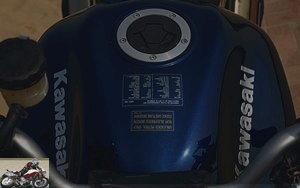
Conclusion

At a time when roadsters are radicalizing, Kawasaki has succeeded
to create a pleasantly usable roadster
on a daily basis, while offering its share of sensations. More torque, more
low, more easily usable, the bike is taken in hand with a real
pleasure. It even gives more confidence in handling
and stability than its little sister Z 750, while being reserved
to experienced bikers. If the affinonados
from the old model loved the explosive side above
of 10,000 rpm, they will be disappointed with the model
2007: that they then keep their motorbike. On the other hand, for all those who
found the old model hollow, they will find their happiness with
this new model. In fact, the 2007 model does not require
more to be unbridled to be pleasant
and reveal all its qualities.
At the same price as a Fazer 1000, more expensive than the Hornet
900 or a Bandit 1200, but cheaper than a Speed Triple, the
Z1000 is in the middle with its 10,499 euros (10,999 € with
ABS).
Strong points
- Mid-range torque / daily use
- Look
- Road holding, braking
Weak points
- Hard seat (rider and passenger)
- Practical: no central stand, no handles
passenger, no place for the lock
Test on the test forum
Competitors: Honda CB 1000 R, Suzuki Bandit 1200,
Triumph Speed Triple, Yamaha
Fazer 1000
2003 vintage test
The technical sheet / comparo
2003/2007
Related articles
-
Kawasaki Z1000 motorcycle test
The Kawasaki Z1000 represents the master stroke of the Akashi manufacturer. Used to its sporting tradition, Kawasaki was rather discreet if not…
-
Kawasaki VN 1600 custom motorcycle test
The boat The VN 1600 is the novelty of 2003 in terms of custom. Since the first Sumo 1500 presented in 1988, the custom largely won in power, handling…
-
Triumph Daytona 600 motorcycle test
The wild stallion With the commercial failure of his 600 TT (and yet it was an excellent GT-Sport cf. test) and its first sporty 4-cylinder, Triumph has…
-
Suzuki SV 1000 S motorcycle test
The sports tractor Presented at Intermot 2002, the SV 1000 is the descendant of the deceased TL 1000S, born itself in 1996: a sporty twin of 1000 cm3…
-
2009 Kawasaki ER-6n motorcycle test
3-day twin-cylinder roadster test The Kawasaki ER6n is Akashi’s twin-cylinder roadster initially introduced in 2005, which has achieved unprecedented…
-
BMW GS 1250 motorcycle test daily
Flat Twin ShiftCam of 1,254 cm3, 136 hp and 143 Nm, 249 kg full made, from 17,599 euros Daily test for 15 days Already more than 800,000 big GS sold in…
-
Honda Hornet 600 – CB600F 2007 vintage motorcycle test
Ten-day test of the 2007 vintage Exit on the heels of the wicked roadsters ago more than 9 years, the CB600F Hornet has been completely revised in 2007….
-
Kawasaki Z 750 motorcycle test
Cure of youth After a big success and more than 62,000 models sold, the Kawasaki Z750 evolves only 3 years later its output: engine, chassis and design….
-
Kawasaki Z 750 R motorcycle test
The Z super Roadster version ! There are emblematic models by their distribution, the commercial enthusiasm they arouse. The Z 750 is in this vein. With…
-
Kawasaki Ninja 1000 SX motorcycle test
Compromise without compromise 4 cylinders of 1,043 cm3, 142 hp and 111 Nm, 235 kg, from 14,349 euros In 2010, Kawasaki presented its first Z1000SX, a…